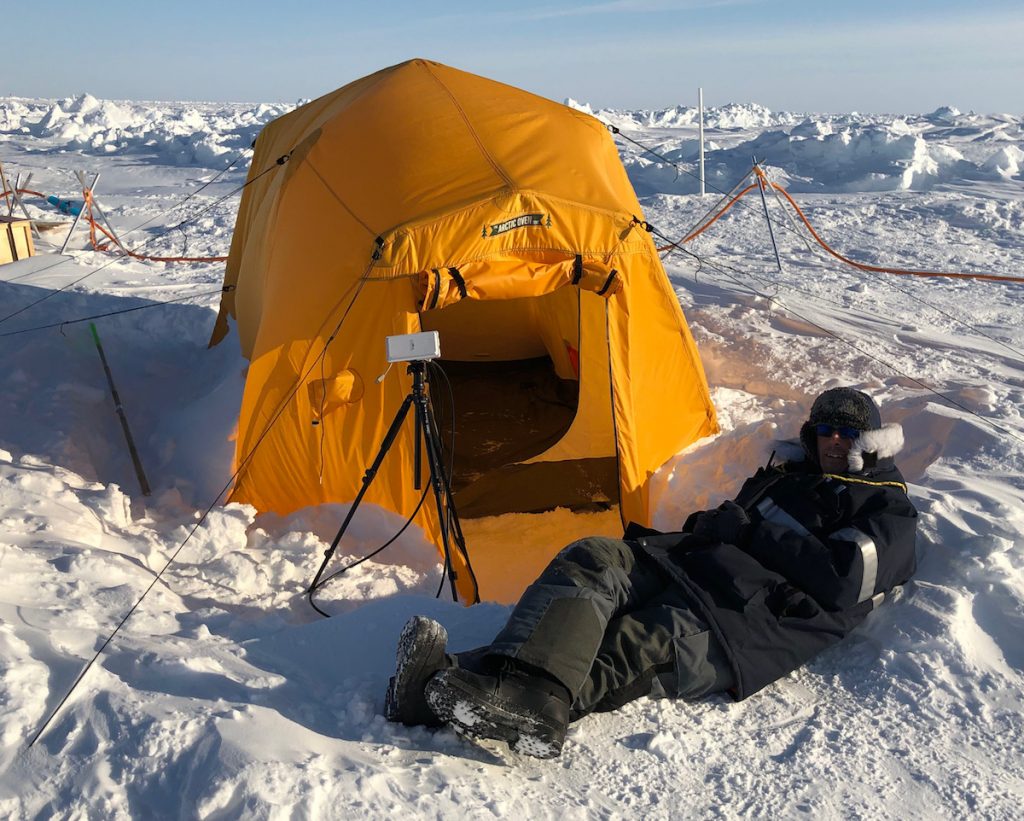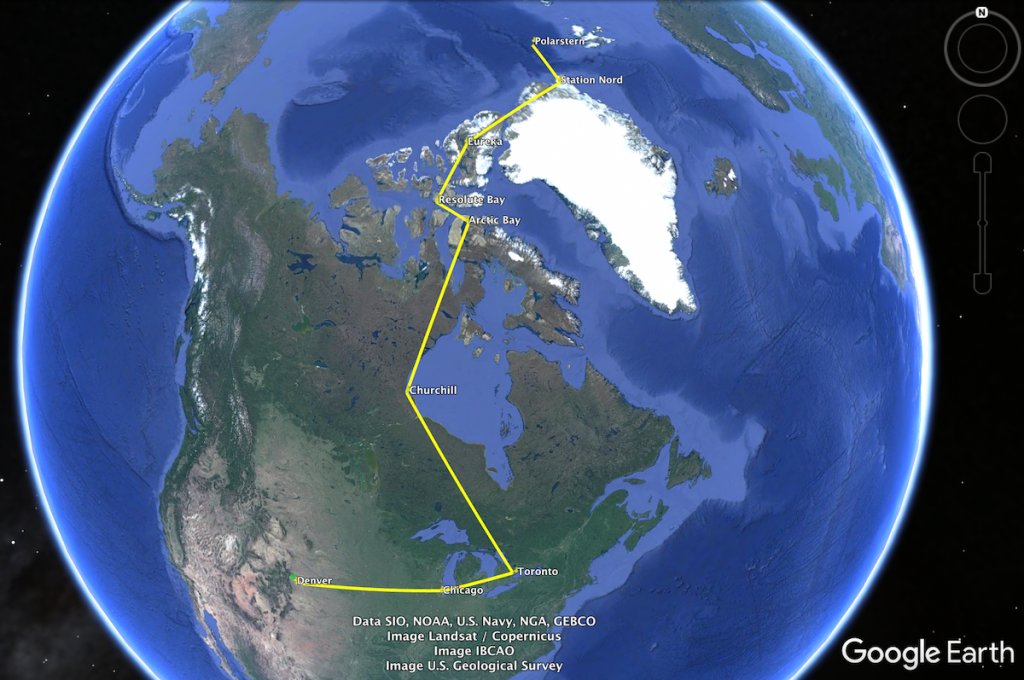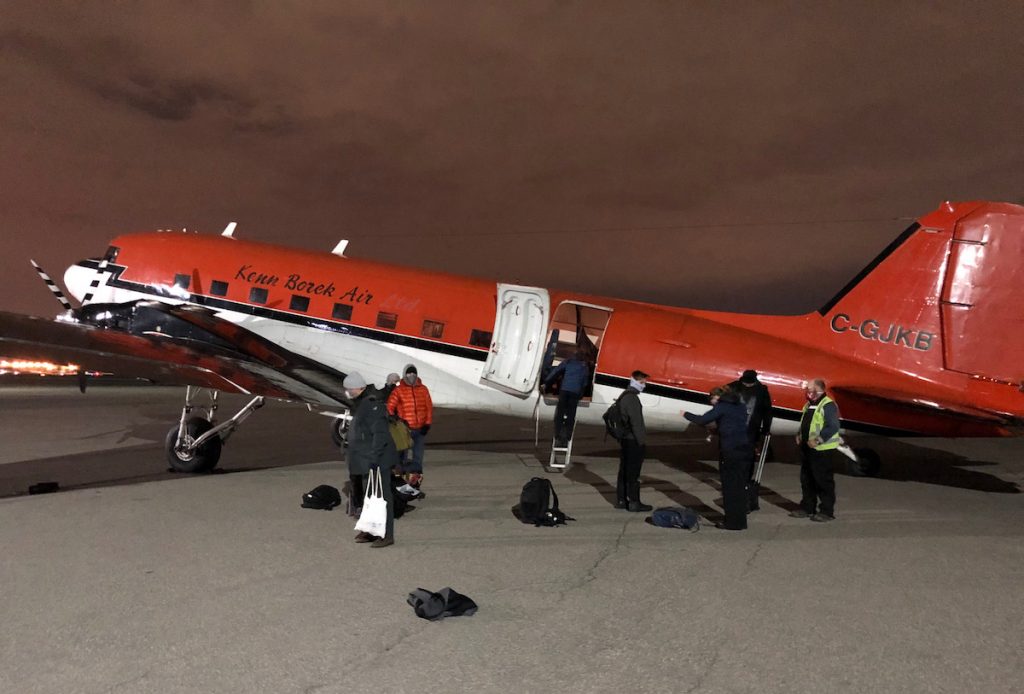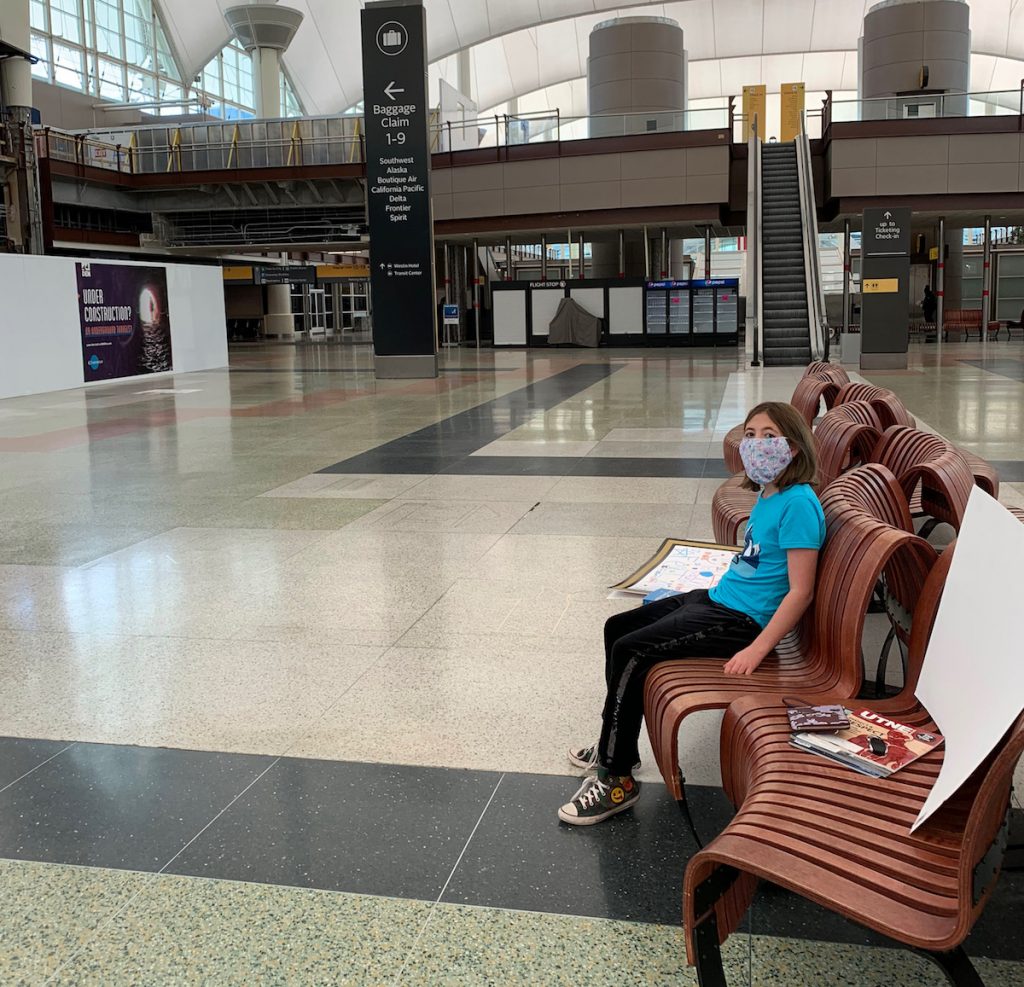As I mentioned in my last blog post, plans were being made for a flight that would allow several people on the Polarstern to return home. That flight took place last Wednesday (22 April) and I was one of the seven people on that flight.
Prior to my flight home, and since my last blog post, Gina and I continued our research doing DataHawk drone flights as often as we could. We were able to do another 11 flights in my last week and a half on the Polarstern. We had beautiful weather after the Easter holiday with clear skies, light winds and temperatures between 0 and 32 deg F. After spending months with temperatures never getting above 0 deg F, and as low as -40 deg F, temperatures in the 20s and 30s F felt downright warm. The nice weather made it easy to fly our drones and we enjoyed our time at Droneville.

But, the easy conditions didn’t last long and another series of storms took aim at the MOSAiC ice floe. These storms brought strong winds with four days of winds of 20 to more than 40 mph. Warm southerly winds at the start of this stormy period raised the temperature to just above freezing and we even had the surprising experience of seeing liquid fall from the sky, in the form of a light drizzle. As the storms moved past us the winds shifted to a northerly direction, bringing cold air back for my last days in the Arctic.
The strong winds and their changing direction created a lot of stress in the ice and this caused several new leads to open up. On the last day that Gina and I flew our DataHawks at Droneville two new leads opened between Droneville and the Polarstern and we had to carefully find our way back to the ship across the new stretches of open water.

As a meteorologist, and a certified weather weenie, I always enjoy seeing exciting weather and strong winds are one of my favorite types of extreme weather. During the last storm I experienced on the MOSAiC expedition winds in excess of 40 mph resulted in so much blowing snow that at times we couldn’t see further than about 100 feet. This reduced visibility only occurred at the surface, since this is where all of the blowing snow is located. If you get to a higher vantage point, like the bridge of the ship, you can see a lot further since you are above most of the blowing snow.

As this final storm wound down it was time for me to shift my focus from drone flights to actual airplane flights. The Alfred Wegner Institute, that organized the MOSAiC expedition, arranged for two Twin Otter aircraft to fly from Greenland to the Polarstern to pick up seven people and bring them to Canada. The Twin Otter is a workhorse plane for remote flight operations. I’ve flown on ski-equipped Twin Otters regularly during my previous Antarctic field campaigns and they are used extensively in the Canadian Arctic.
Twin Otters need only a short, relatively smooth area to land and take-off. Before I had even arrived on the Polarstern the crew of the ship had prepared a groomed snow runway in case a flight was needed for a medical emergency. This groomed runway would serve as the runway for the Twin Otter flight that would start my journey home.
My Twin Otter flight was originally scheduled for Sunday, 19 April, but the stormy weather I described above resulted in this flight being delayed until Wednesday, 22 April. I woke on Wednesday morning to blue skies and beautiful conditions on the ice floe and on Wednesday afternoon two Twin Otter aircraft landed on the sea ice next to the Polarstern.

It was bittersweet seeing the Twin Otter arrive. I was so happy that I’d soon be on my way home to my family, after more than three months away from them, but I was also sorry to be leaving my friends and colleagues on the Polarstern. The relationships you develop while doing fieldwork, compared to those at home, tend to form more quickly and become stronger as a result of the unique challenges you face together and because the community of people you see every day is so much smaller than when you are at home.
Just before 4PM on Wednesday the Twin Otter I was on took off from the MOSAiC ice floe. It was strange looking out of the window of the plane and seeing the ice zip past below us at more than 100 mph after not traveling at more than a walking pace for the past 1.5 months since I arrived at the Polarstern. After a 2.5 hour flight we had reached the northeastern coast of Greenland and Station Nord.

Station Nord is a Danish military base and scientific research station and was the closest place that could serve as a jumping off point to the Polarstern for our Twin Otter flight. As a result of the coronavirus the base was populated by just 5 Danish military personnel with no scientists at the research station. We spent a comfortable night at Station Nord in the empty science dorm.
At 8 AM on Thursday morning we started a very long day of travel. From Station Nord we flew along the northern edge of Greenland and across Ellesmere Island in the Canadian high Arctic. Ellesmere Island is a name that conjures visions of harsh Arctic conditions and I was excited that I’d get the chance to see this remote island and even set foot on it. The landscape was as dramatic as I had imagined with snow covered plateaus and jagged mountain peaks. Seeing this landscape scroll past me as I flew over it in a small plane was an experience I’ll always cherish.


Our first stop of the day was Eureka and there wasn’t much there besides a snow covered runway and a few buildings. We spent about 45 minutes on the ground as the two Twin Otter aircraft were refueled from fuel barrels on the side of the of the runway.

From Eureka we continued flying south across the Canadian archipelago. Our next stop was Resolute Bay. Here we transferred from the small Twin Otter aircraft to a larger DC-3 Bassler aircraft. After another 40 minutes on the ground we were once again on our way.
We stopped briefly at the community of Arctic Bay, where one of the people traveling with us from the Polarstern was dropped off and reunited with his family. We then had a long 5 hour flight south to Churchill, Manitoba, on the shore of Hudson Bay. Churchill bills itself as the polar bear capital of the world and is one of the most popular tourist destinations in the world for seeing polar bears. Normally, Churchill would be busy with tourists at this time of year, but because of all of the coronavirus related travel restrictions we were the only people at the airport.
Our stop here was noteworthy for two things. It was the first time I’d seen a tree, or any vegetation, since leaving the fjord north of Tromsø almost 3 months earlier. It was also the first place where I was able to use my cell phone again and I took the opportunity to call home and let my wife and daughter know that I was on my way back to them.
After a 40 minute stop at Churchill, to refuel, we were back in the air and continuing south. It was another 5 hour flight from Churchill to Toronto. During this flight I saw my first completely dark sky in over a month. I always miss the night sky when I do summer polar fieldwork, when the sun never sets. It was beautiful seeing a black sky filled with a million stars as we flew over the vast boreal forest of Canada. As we neared Toronto the sight of the lights of the city and the millions of people living there was shocking after not seeing any towns or more than 100 people in almost 3 months. The transition from polar fieldwork back to civilization is always one with lots of new sights that normally would be taken for granted in our everyday lives.
We landed in Toronto at 3 AM, 21 hours after we left Station Nord. I arrived at my hotel at 4 AM and had enough time to shower and send a few e-mail messages before it was time to head to the airport, at 5:30, to catch the commercial flights that would take me home.

My return to civilization was stranger than usual thanks to the new normal of a world dealing with the coronavirus. What would normally be busy airports were almost deserted. Everyone was wearing face masks and keeping lots of space between themselves and anyone else that was around. Normally, a return from polar fieldwork provides a shock in seeing so many people when you step off of the plane, but it was the exact opposite experience this time.
From Toronto I flew on an almost empty Air Canada flight to Chicago. Chicago O’Hare is one of the world’s busiest airports, but at midday on this Friday there were only a handful of people walking through the terminal as I made my way to the gate for my last flight of the trip. From Chicago I took a United flight to Denver. Despite not sleeping the previous night I was too excited about soon seeing my wife and daughter to sleep on this flight.


I was so happy as I stepped into the main terminal at the Denver airport and saw Liz and Sabrina waiting for me. I love doing polar fieldwork but the long time away from my family is the hardest part of doing this type of work. After our initial hugs and kisses it was wonderful to be able to carry on a normal conversation with them after months of largely communicating with e-mail.
As we drove from the airport to my home in Louisville I savored the familiar sights. I’d missed the beautiful wide open views across the high plains with the Rocky Mountains rising on the western horizon. It was still unreal to me to see colors other than white and gray and blue that dominated my world for the last 3 months.
After a welcome home celebration, that Sabrina had been planning for months, we enjoyed a family bike ride on the open space near our home. Despite the lockdowns associated with the coronavirus, outside exercise is still allowed. I was excited to go for a bike ride in warm, spring weather, wearing nothing more than shorts and a T-shirt, after months of having to bundle up in cold weather gear anytime I stepped outside.

I am enjoying being home with my family again as I slowly adjust to the new normal of the coronavirus world I’ve returned to. I am busy catching up on all of the work tasks I’d neglected while I was away in the field. I’m also in regular e-mail contact with Gina as she continues our work on leg 3 of the MOSAiC expedition. She’s done several DataHawk flights, with Julia, since I left and apparently a polar bear visited Droneville the day after I left. Several times a day I catch myself thinking about the people still on the Polarstern and I wonder what they are doing and experiencing. I hope that the rest of leg 3 goes well for them and that they all get home to their families soon.
My next polar field campaign is scheduled for January 2021 and will take place in Antarctica. I’ll be posting new blog entries here once that trip begins.
Thanks for reading my blog. I hope everyone that has been reading this blog is staying safe and healthy.
John

I’ve thoroughly enjoyed reading your blog, John. We’ve worked together for several years now and it was a pleasure to meet you — in person for the first time — at the Norwegian Polar Institute in Tromsø just before your departure. Thanks for sharing your ups and downs on the MOSAiC research expedition, which you describe so well. Enjoy a much-deserved rest at home!
Thanks Helle. It was nice to finally meet in Tromsø before I left for the expedition. That seems like a long time ago now.
Hello!
I am a student at California Polytechnic University studying Aerospace Engineering. I am currently working on my senior design project; an aircraft meant to deliver supplies to the South Pole resupply mission during the winter time.
Based on all your experiences, I was wondering if I could do a short interview or at least ask some questions! Do you have time for a quick interview or email exchange?
Thanks!